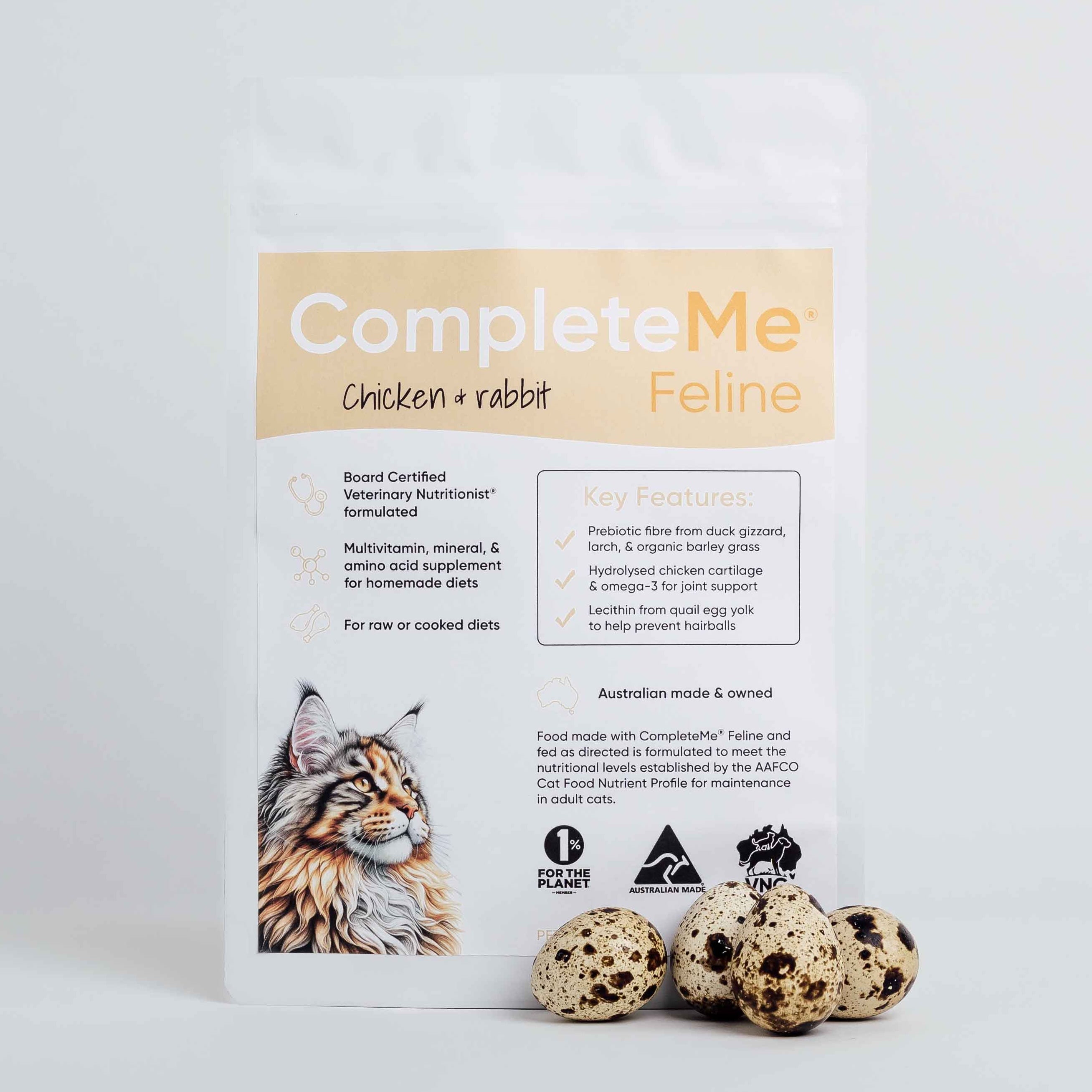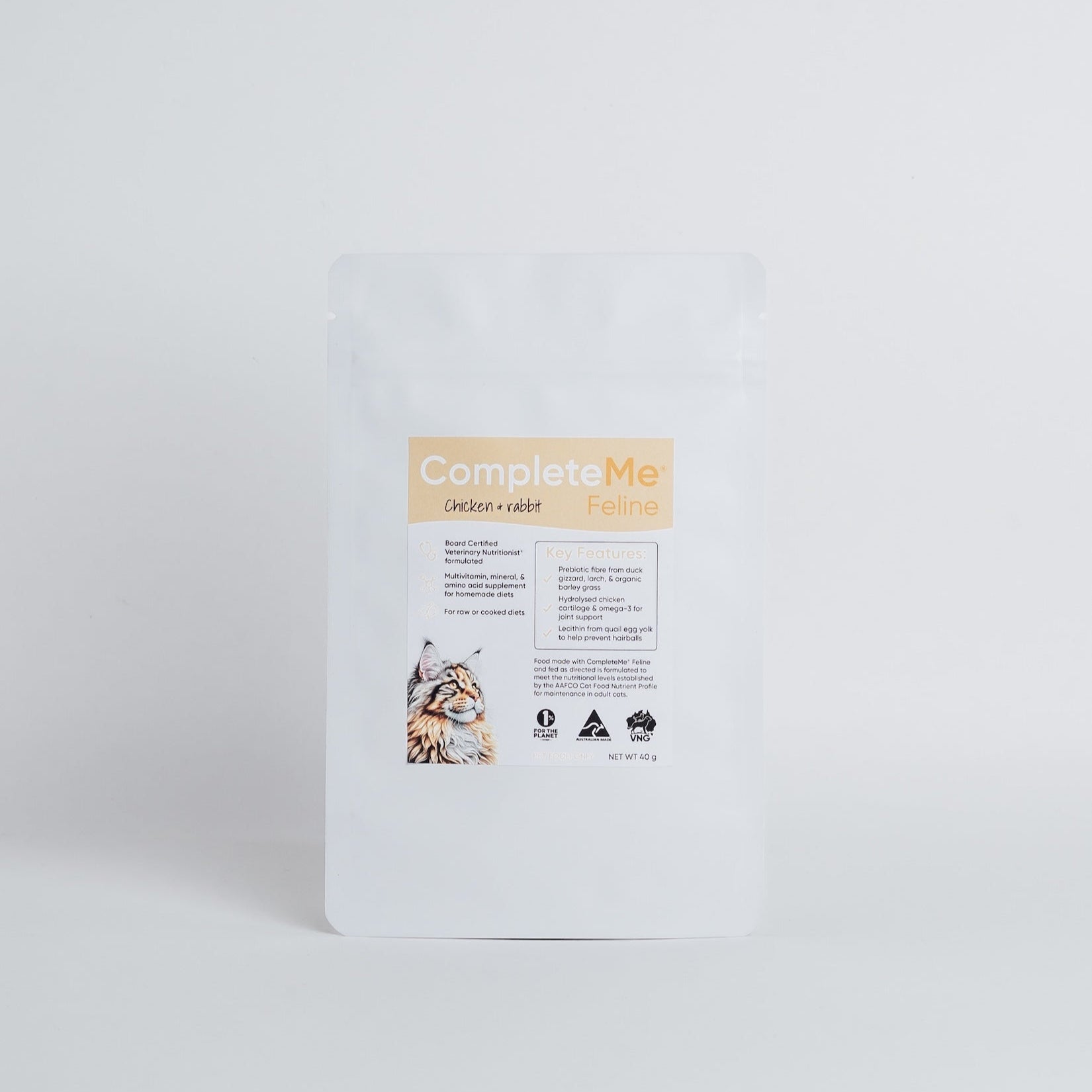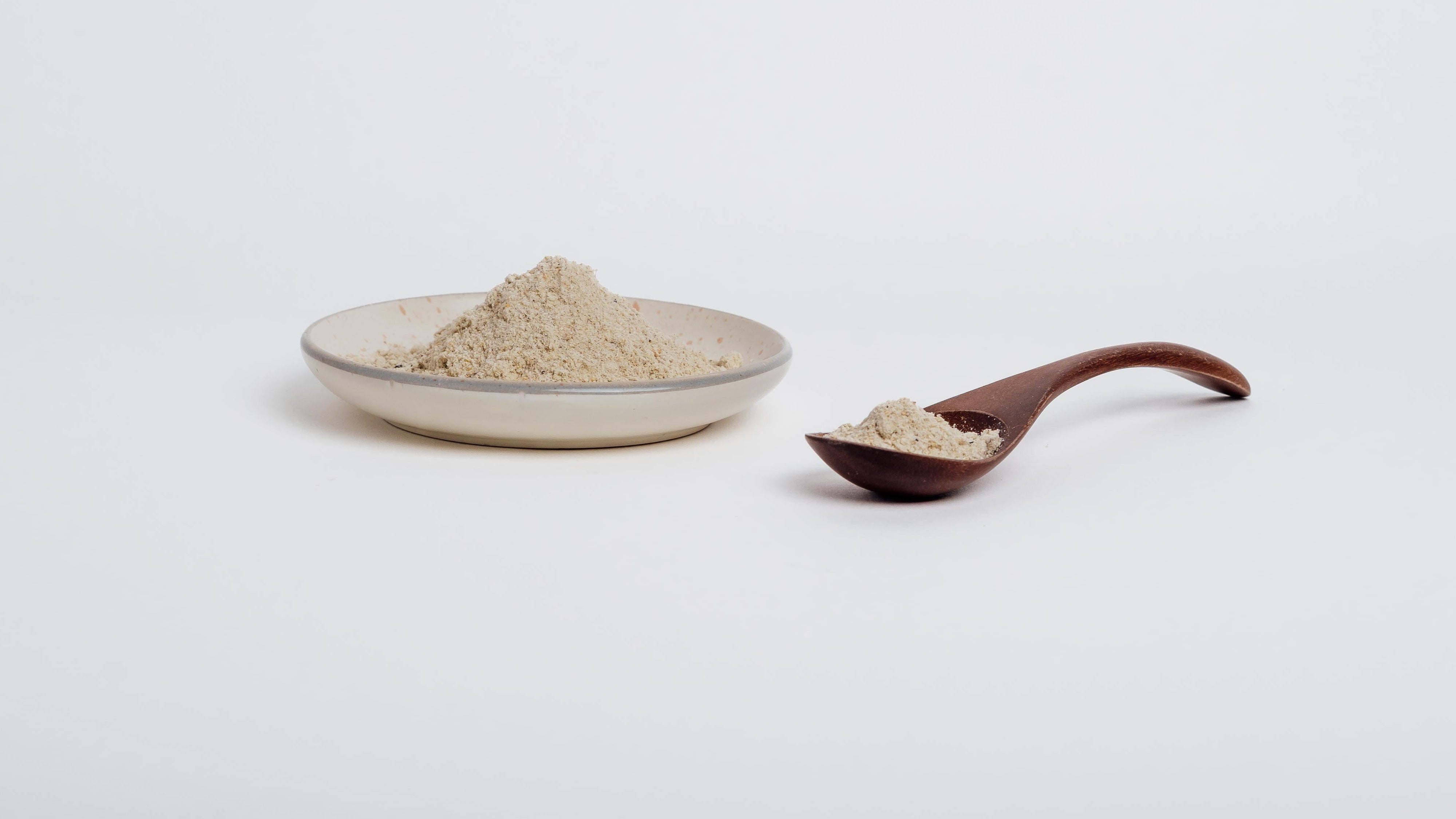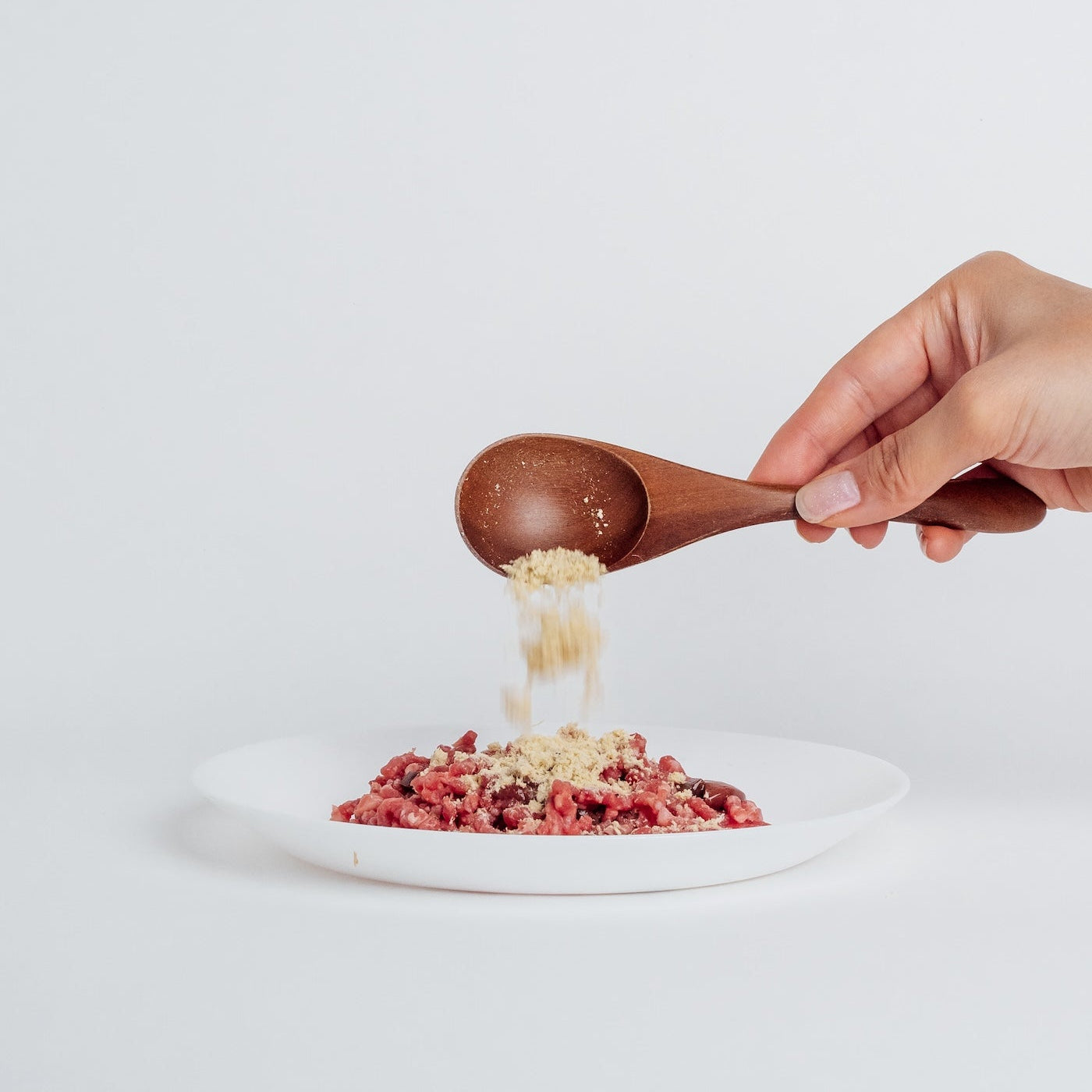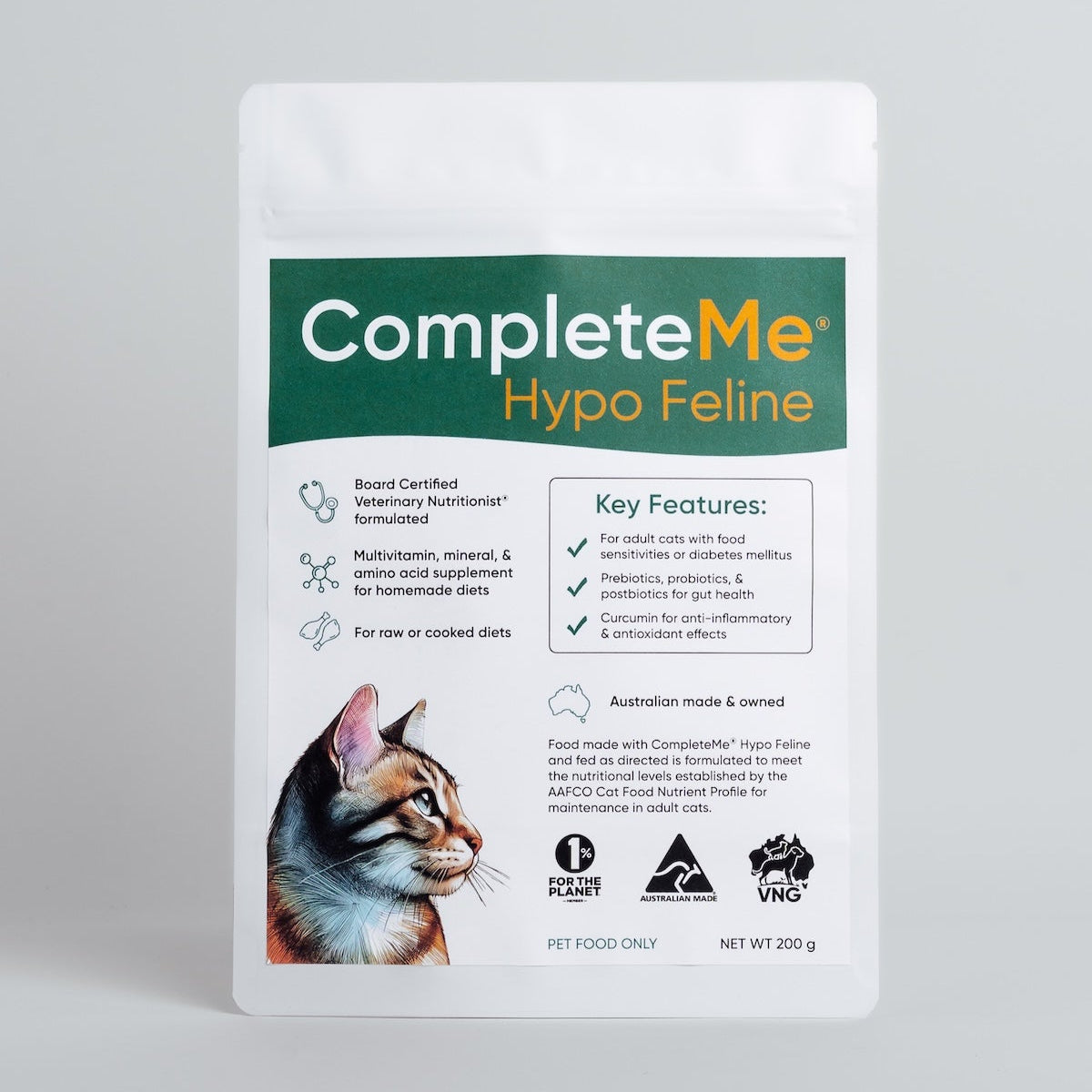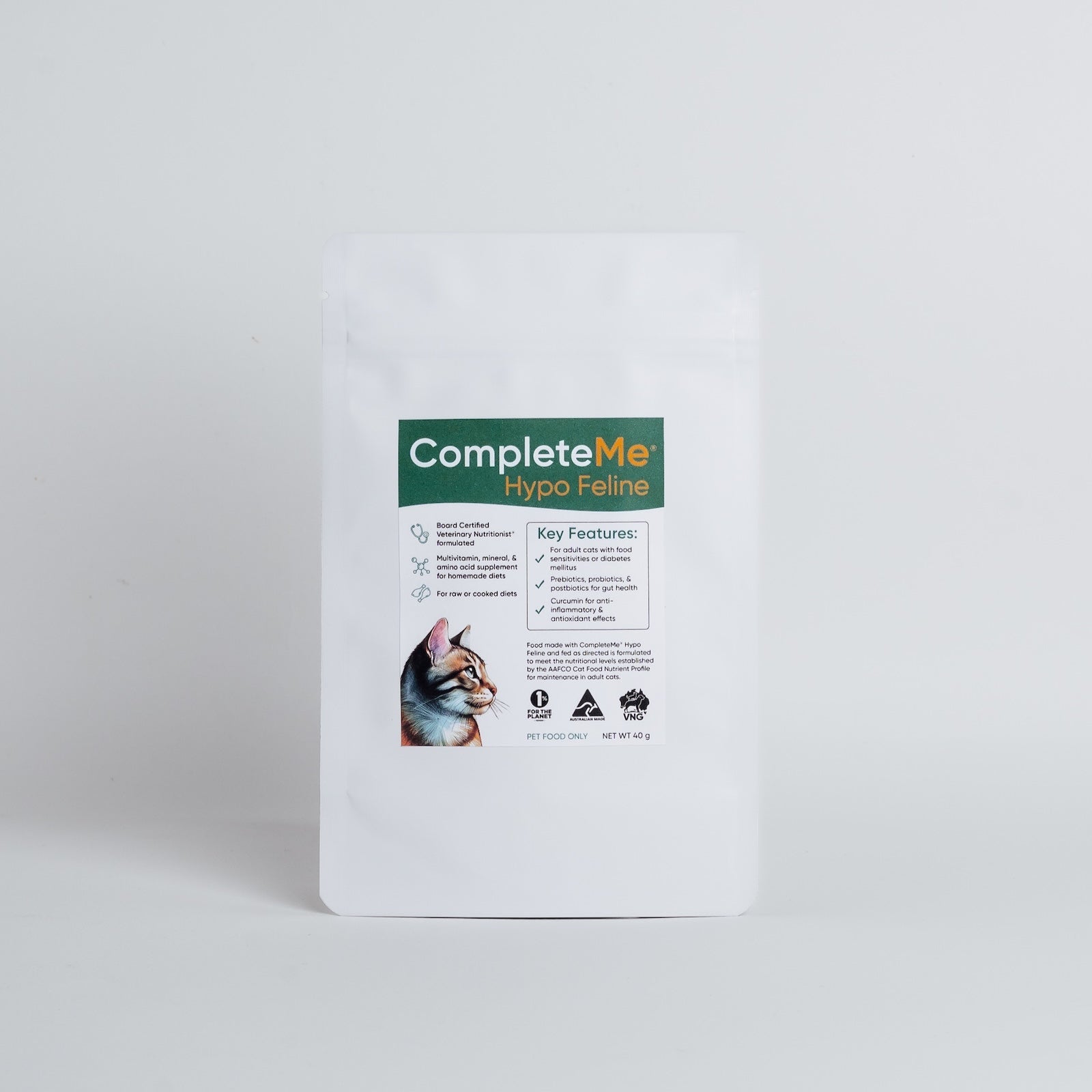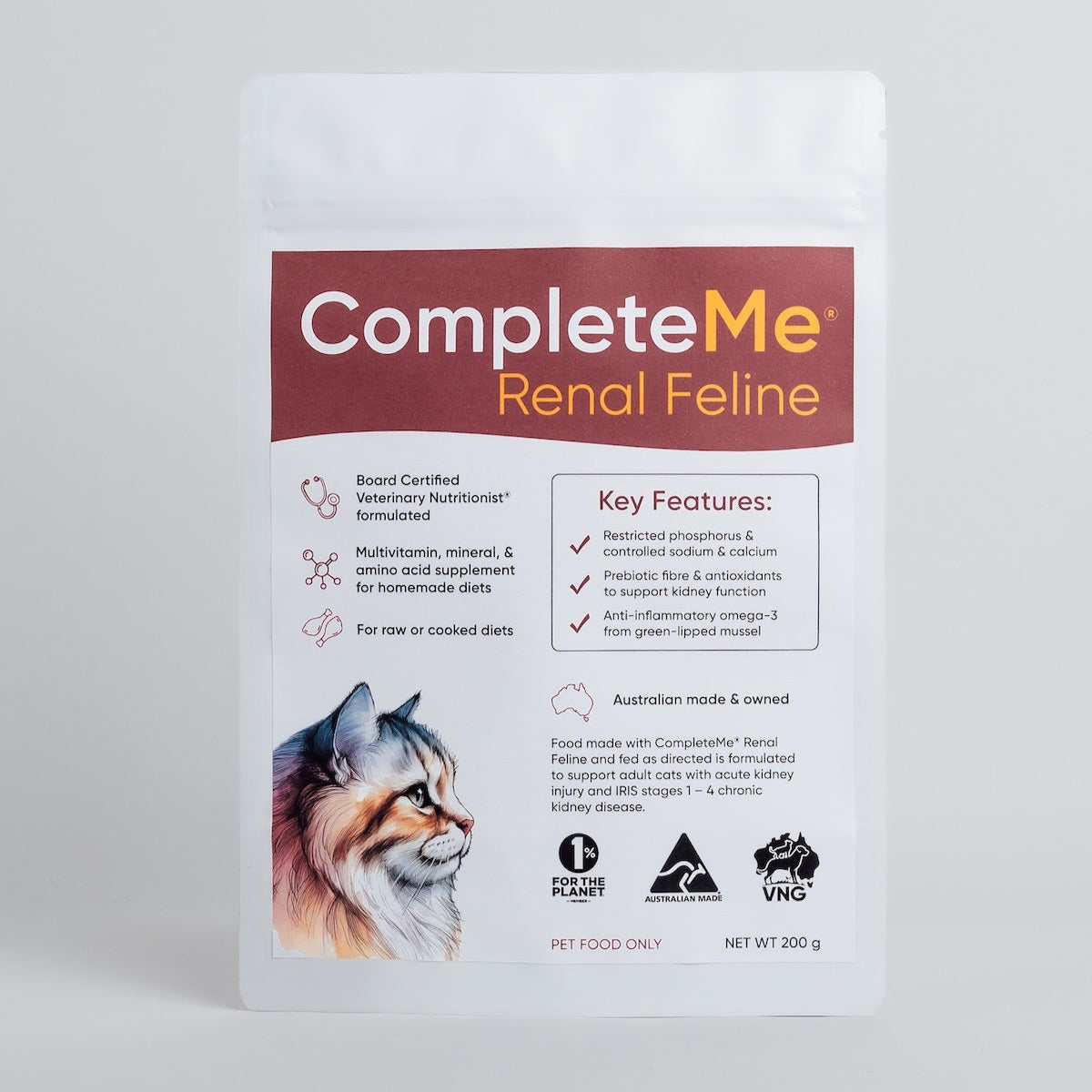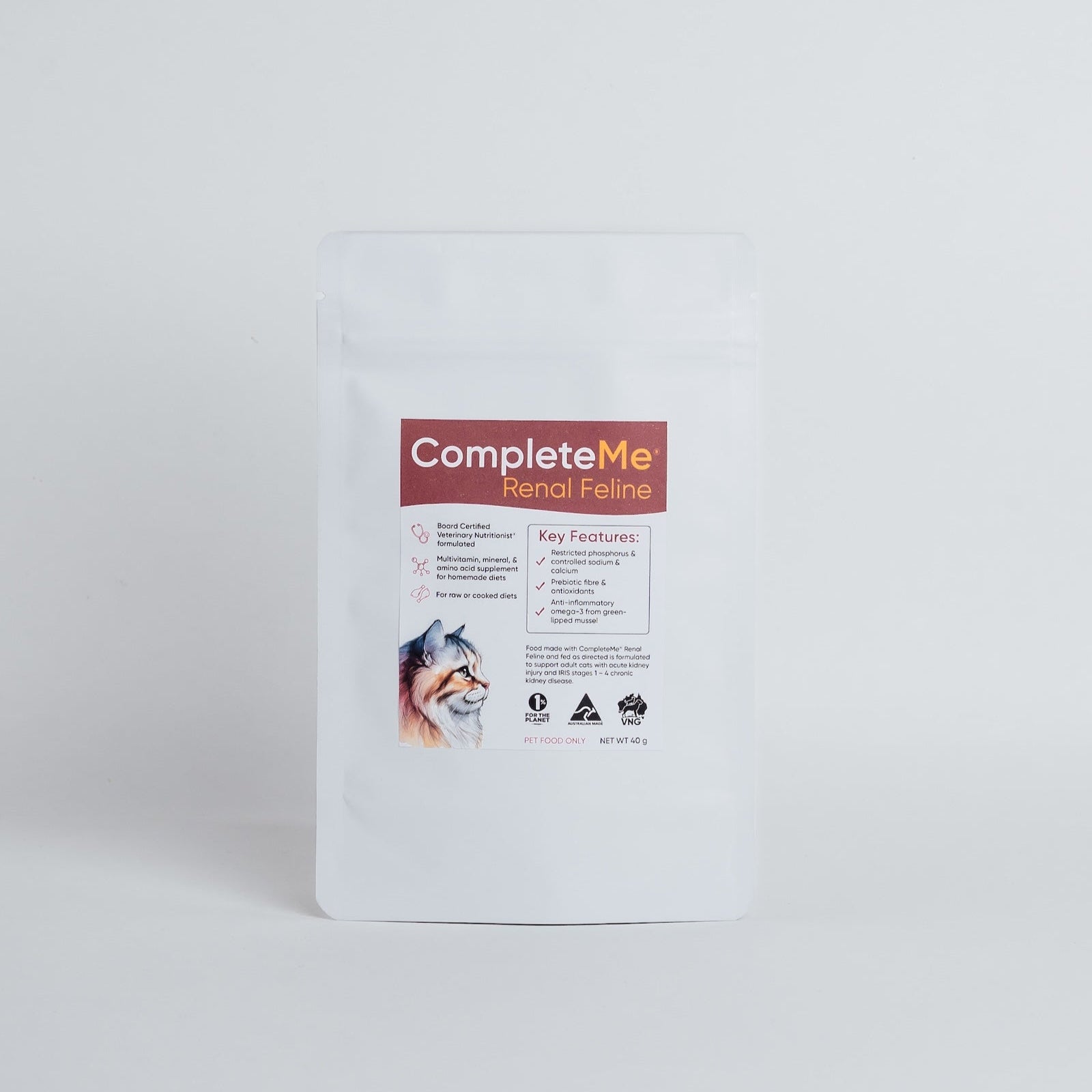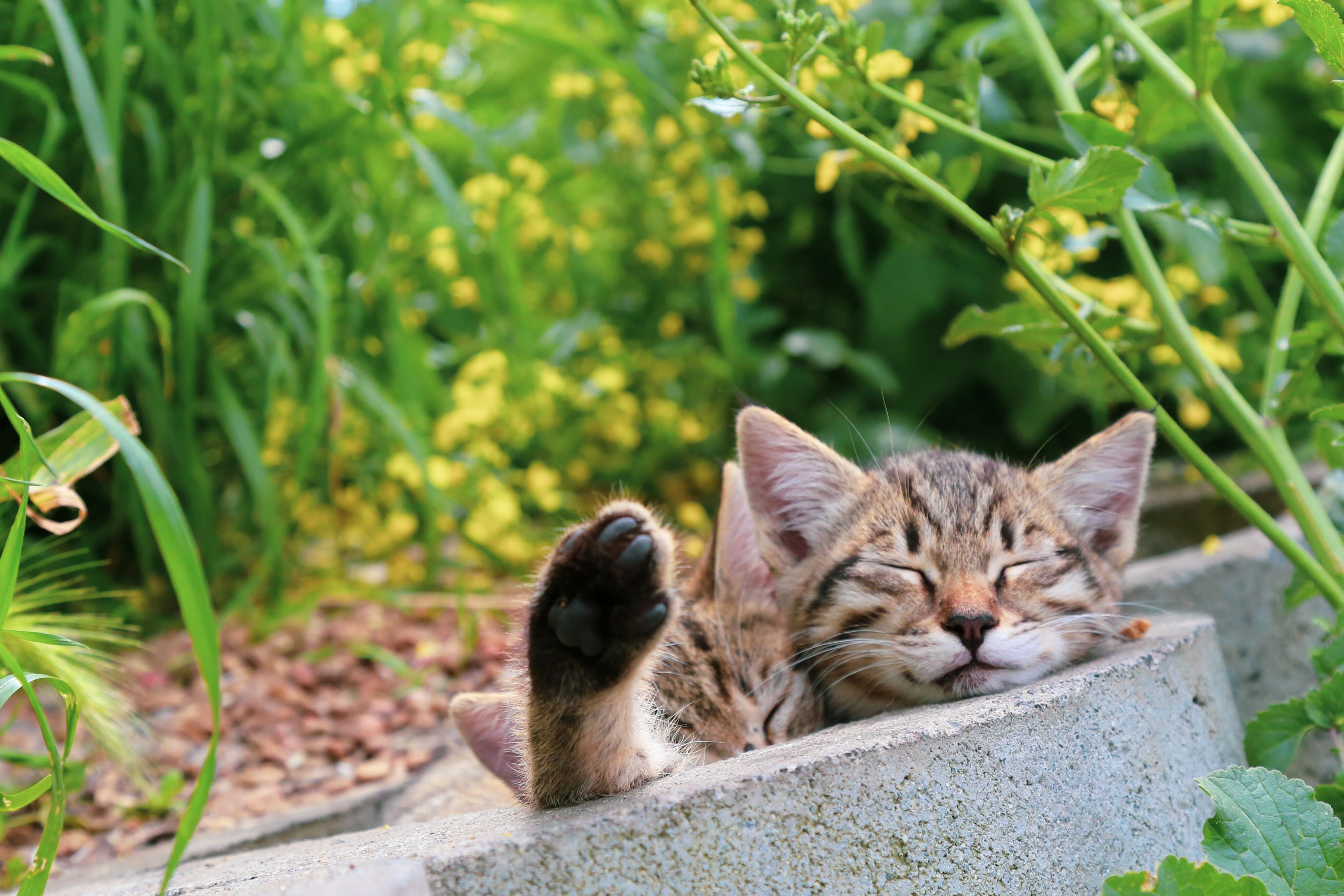
Feeding guide for healthy kittens
With CompleteMe Kitten
Make delicious, high protein, balanced cat food at home quickly and easily. Formulated for growth and reproducing female cats.
Choose the meat and other ingredients you would like to use with our simple, flexible guide. Options to add extra fibre, omega-3 and antioxidants for joint, gut and skin health.
Makes 1 kilogram of food, which can be portioned and frozen.
Ingredients
1 kilogram of lean raw muscle meat (2-10% fat)
Please see the FAQs below for options for meat types and cuts.
50-100 mL of water, goats milk, or bone broth
45 grams of CompleteMe Kitten
Optional:
2 mL of omega-3-rich oil
(choose from: fish oil, salmon oil, krill oil, marine algae oil)
For kittens and reproducing females, we like oils rich in DHA for healthy brain and eye development.
1 to 3 teaspoons of prebiotic fibre
(choose from: chia seeds, oat or barley bran, psyllium husk, hydrolyzed collagen or gelatine)
Directions
Batch prep with raw meat:
- Dice or grind the raw meat, as desired.
- Combine with 45 grams CompleteMe Kitten, 50-100 mL water, and any optional ingredients, and mix again.
- Portion and refrigerate, or freeze.
Batch prep with cooked meat:
- Gently cook the diced or ground meat in a pot or slow cooker with 50-150 mL water, until cooked (20-40 minutes).
- Allow to cool, then combine the cooked meat (including liquid from pot), 45 grams of CompleteMe Kitten, and any optional ingredients, and mix well.
- Portion and refrigerate, or freeze.
How to make individual meals:
Combine 50 grams of raw boneless meat (2-10% fat) with 1/2 (one half) level teaspoon (2.3 grams) of CompleteMe Kitten, and 1 teaspoon of water or bone broth. Mix and serve.
Storage and safety
Do not add CompleteMe Kitten to any commercial cat food, or use with any other nutritional supplements (containing vitamins and/or minerals).
For raw meat, freeze for 10 days before use to destroy parasites like Toxoplasma. In areas with Trichinella, please freeze pork for 3 weeks before use. In areas with highly pathogenic avian influenza, we recommend avoiding raw poultry.
Larger batches can be made and frozen for convenience. Keep refrigerated food for 3 days, and frozen food for 3-4 months. Please discard any uneaten food after 30 minutes.
Feeding guidelines
Kittens less than 5 months old can be fed as much as they would like. For kittens 5 to 18 months old, we recommend feeding 5-10% of bodyweight. Adjust up or down based on your kitten's size, age, body condition, and activity level. Free-choice feeding is the preferred method for pregnant or nursing queens. Assess food intake and weight gain at least weekly, in consultation with your cat's vet.
This is a general guideline; please consult with your cat's veterinarian as needed. We recommend feeding kittens 4 to 6 meals per day, depending on age.
Nutritional information
Food made as per the instructions above is complete and balanced, and meets the nutritional levels established by the AAFCO Cat Food Nutrient Profile for growth and reproduction.
For adult cats, we recommend using CompleteMe Feline.
The average kcal/gram for the diet is: 1.6 kcal/gram
The average protein for the diet is:
68% on a dry matter basis
59% on a caloric basis
The average fat for the diet is:
22% on a dry matter basis
41% on a caloric basis
Average phosphorus for the diet is:
0.34% as fed basis
1% dry matter basis
2.2 g per 1000 kcal ME
All possible combinations are ultra-low in carbohydrate, high in moisture, and have appropriate calcium, magnesium and sodium.
FAQs
What meats can I use?
A large number of meats and cuts can be used with CompleteMe Kitten. Variety is important; we strongly recommend feeding a range of different meat types and cuts. Don't exclusively feed very lean meats; this is especially important for breeding females. 5-8% fat is a good everyday choice for kittens; this equates to about 55-65% calories from protein, similar to the diet of a feral cat or small wild cat. 8-10% fat may be more suitable for queens. Be sure to feed occasional higher and lower fat meals as well. As your kitten grows, try to include different textures as well, for example, chunks, small strips, mince, etc.
- Poultry:
Skinless and boneless chicken thigh, drumstick or breast, mince (2-3% fat), gizzards, hearts (fat trimmed off)
Skinless and boneless turkey or duck breast - Pork:
Lean pork mince or diced pork loin with 5-10% fat, rump steak (untrimmed) - Lamb, beef, goat, or venison:
Extra-lean diced lamb or goat meat (including heart or tongue) with 5-10% fat
Lean venison fillet or steak (e.g. shoulder, backstrap, rump eye, leg steak)
Extra-lean (5 star) beef mince, gravy or chuck beef with 5-10% fat, blade, round or rump steak (fat trimmed off), eye fillet or topside roast or steak (fat trimmed off) - Game meat:
Lean kangaroo mince or steak with 2-3% fat
Wild or farmed boneless rabbit or hare meat
Emu fan fillet or flat fillet (1-3% fat)
Wild boar backstrap, boneless leg, or loin chops
Should I add offal to the diet?
Please do not add any additional liver, kidney, pancreas or spleen to the diet. This could result in an excess of some nutrients. Heart, gizzards and tongue can be used as muscle meats; please trim off visible white fat around the base of the heart before using.
Why add extra omega-3 or fibre to my kitten's diet?
DHA (docosahexaenoic Acid), an omega-3 fatty acid, is natural omega-3 fatty acid essential in the development of the brain and nervous system in kittens. It is found in fish oil, krill oil, or marine algae oil. Plant-derived oils like flaxseed oil do not provide any DHA. Research suggests that DHA supplementation in young animals can improve learning and memory, including long-term memory and problem-solving abilities. CompleteMe Kitten contains DHA from marine algae, however adding a little more decreases the omega-6 to omega-3 ratio of the diet, and provides an even greater DHA boost.
Young kittens can be at risk of diarrhoea and fibre may help to normalise stool consistency during periods of dietary transition. It can also support the growth of a robust and diverse gut microbiome.
Can I use raw meat?
You can include the meat raw or cooked, depending on preference. For raw human-grade meat, be sure to freeze the meat for 10 days prior to use. For wild-caught meats or pork (in areas with Trichinella, freezing for 3 weeks prior to use is sensible. Please discuss raw-feeding with your kitten's veterinarian; raw feeding is not suitable for all kittens or households.
What age range is this suitable for?
If desired, kittens can be weaned on to this diet from around 4 weeks of age. Most kittens should be transitioned to an adult diet at around 12 months of age, or whenever they are skeletally mature.
Pregnant females should be transitioned to a kitten diet from conception onwards, and should continue to be fed this until the kittens are weaned.
For quick and easy homemade meals
CompleteMe Feline - Chicken & rabbit
CompleteMe Feline - Venison & kangaroo


